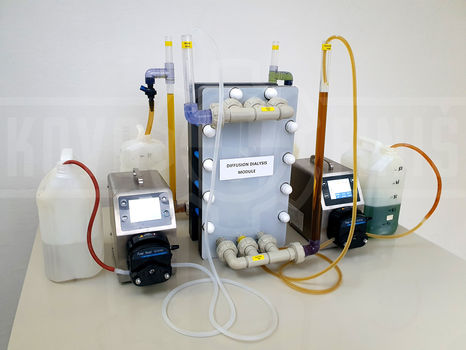Laboratory and trial testing
Kovofiniš has laboratory and trial plant facilities for testing membrane processes, vacuum evaporation, ion-exchange processes and advanced oxidation processes (AOP). These facilities are used both for the development and validation of new technologies and for tests with real solutions or wastewater. We can thus offer to our customers the verification of different technologies directly on their real solutions and wastewater.
Ultrafiltration trial testing plant
It is intended mainly for testing the purification and recycling of industrial wastewater, or the filtration of surface and underground water, primarily as a pre-stage to reverse osmosis.
It is a hollow fibre ultrafiltration module, available with two different hollow fibre diameters. The testing plant is equipped with both backwash and chemically enhanced backwash and it is automatically controlled. It allows the selection of the most suitable module type, optimum operating conditions and flushing method for given case, as well as the monitoring of fouling and contamination of the module, thus optimising the pre-treatment before ultrafiltration and suggestion of appropriate cleaning method for the module.
Reverse osmosis trial testing unit
It is mainly intended for testing the treatment and recycling of industrial wastewater.
It is a high-pressure reverse osmosis unit with a working pressure of up to 42 bars. The high-pressure pump is equipped with a frequency converter to regulate the pump output. The unit can be operated with either one 4" diaphragm or two 4" diaphragms connected in parallel.
The unit allows testing of different types of diaphragms, suggestion of appropriate diaphragm type and the optimum operating conditions for given case, but also monitoring fouling and contamination of the diaphragms and thus optimizing the pre-treatment before reverse osmosis and suggestion of appropriate diaphragm cleaning method.
Diffusion Dialysis Laboratory Unit
Used to test the recycling of mineral (inorganic) acids and/or metals from solutions of these acids and their metal salts, such as in particular metal pickling, etching or stripping baths and anodic aluminium oxidation baths.
Testing results in data on the efficiency and performance of the diffusion dialysis process for the specific solution tested, which can be used to design a fully operational plant.
Tests can be performed on the laboratory module with hydrochloric, sulphuric, nitric and hydrofluoric acid solutions up to the following maximum concentrations: hydrochloric acid 35%, sulphuric acid 40%, nitric acid 25%, hydrofluoric acid 10%.
Laboratory vacuum evaporator
It is used for initial tests of vacuum evaporation technology with various solutions and wastewaters.
It is a rotary vacuum evaporator with an automatically controlled vacuum pump and adjustable pressure, heating bath temperature and flask rotation speed over a very wide range.
Tests on this evaporator are used to obtain information on the evaporation behaviour of the solution, such as evaporation rate, foaming or precipitate formation, or on the possible degree of concentration of the input solution. During the tests, a sufficient quantity of distillate is obtained for analysis in order to evaluate the quality of the distillate.
Trial test vacuum evaporator
It is used to validate vacuum evaporation technology on a semi-operational measuring.
It is a forced circulation evaporator with an external heat exchanger and external source of heat/cold, heating by hot water and cooling by a cooling tower. The evaporator allows pressure adjustment in the range of approximately 6-32 kPa, corresponding to boiling temperatures of approximately 35-70°C.
Trial test ion-exchange unit
It is used to test and validate ion-exchange-based technologies, especially for the areas of wastewater treatment/recycling and surface treatment. Examples include recycling valuable substances from wastewater/solutions or removing undesirable substances from process solutions/baths for recovery. In addition to processes based on real ion exchange, the unit is also used to test acid retardation processes.
The unit is equipped with two ion-exchange columns, whose variable interconnection allows either of the columns to be connected individually or both columns in any order, and a pump with adjustable power for a wide range of flow rates.
The unit allows to test different types of ion-exchanges, to obtain information e.g. on sorption efficiency or ion-exchange capacity and to determine the optimum operating conditions for a given application.
Trial test plant for advanced oxidation processes (AOP)
It is designed to test the wastewater treatment using advanced oxidation processes. The plant allows the following processes to be tested on model solutions and real wastewater:
oxidation processes
- ozone oxidation (O3) - ozonation
- hydrogen peroxide oxidation (H2O2)
- oxidation of O3 + H2O2 - Peroxon
photochemical oxidation processes
- oxidation of O3 + UV radiation
- oxidation of H2O2 + UV radiation
- photoFenton oxidation - ferrous (Fe2+) or ferric (Fe3+) ion + H2O2 + UV radiation












